The AMD Ryzen 3 3300X and 3100 CPU Review: A Budget Gaming Bonanza
by Dr. Ian Cutress on May 7, 2020 9:00 AM ESTCPU Performance: System Tests
Our System Test section focuses significantly on real-world testing, user experience, with a slight nod to throughput. In this section we cover application loading time, image processing, simple scientific physics, emulation, neural simulation, optimized compute, and 3D model development, with a combination of readily available and custom software. For some of these tests, the bigger suites such as PCMark do cover them (we publish those values in our office section), although multiple perspectives is always beneficial. In all our tests we will explain in-depth what is being tested, and how we are testing.
All of our benchmark results can also be found in our benchmark engine, Bench.
Application Load: GIMP 2.10.4
One of the most important aspects about user experience and workflow is how fast does a system respond. A good test of this is to see how long it takes for an application to load. Most applications these days, when on an SSD, load fairly instantly, however some office tools require asset pre-loading before being available. Most operating systems employ caching as well, so when certain software is loaded repeatedly (web browser, office tools), then can be initialized much quicker.
In our last suite, we tested how long it took to load a large PDF in Adobe Acrobat. Unfortunately this test was a nightmare to program for, and didn’t transfer over to Win10 RS3 easily. In the meantime we discovered an application that can automate this test, and we put it up against GIMP, a popular free open-source online photo editing tool, and the major alternative to Adobe Photoshop. We set it to load a large 50MB design template, and perform the load 10 times with 10 seconds in-between each. Due to caching, the first 3-5 results are often slower than the rest, and time to cache can be inconsistent, we take the average of the last five results to show CPU processing on cached loading.
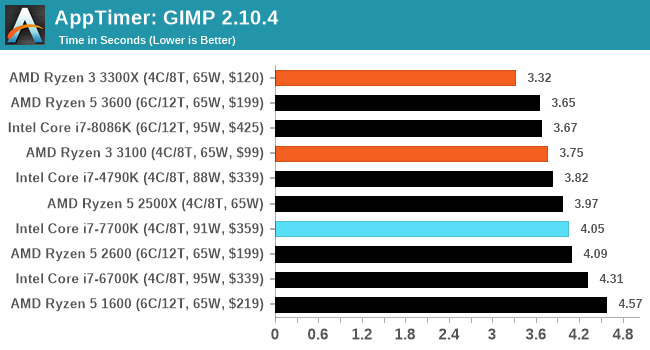
3D Particle Movement v2.1: Brownian Motion
Our 3DPM test is a custom built benchmark designed to simulate six different particle movement algorithms of points in a 3D space. The algorithms were developed as part of my PhD., and while ultimately perform best on a GPU, provide a good idea on how instruction streams are interpreted by different microarchitectures.
A key part of the algorithms is the random number generation – we use relatively fast generation which ends up implementing dependency chains in the code. The upgrade over the naïve first version of this code solved for false sharing in the caches, a major bottleneck. We are also looking at AVX2 and AVX512 versions of this benchmark for future reviews.
For this test, we run a stock particle set over the six algorithms for 20 seconds apiece, with 10 second pauses, and report the total rate of particle movement, in millions of operations (movements) per second. We have a non-AVX version and an AVX version, with the latter implementing AVX512 and AVX2 where possible.
3DPM v2.1 can be downloaded from our server: 3DPMv2.1.rar (13.0 MB)
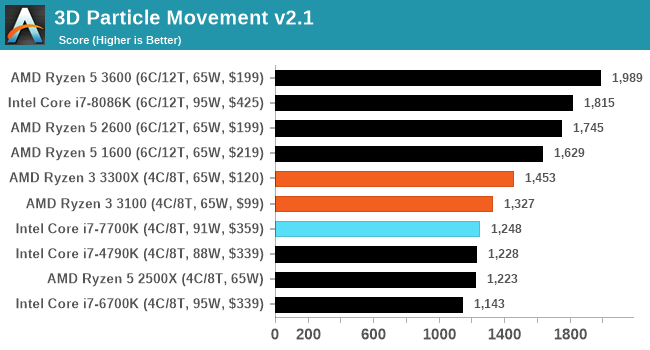
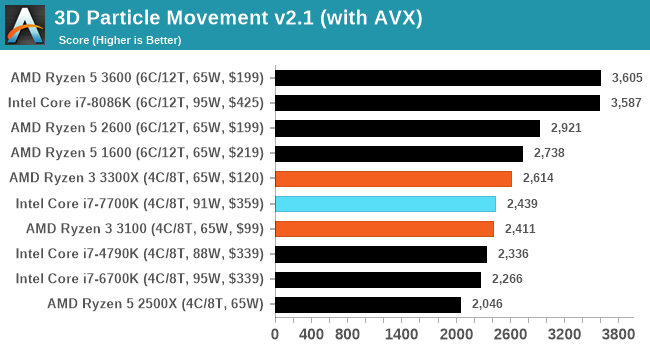
Dolphin 5.0: Console Emulation
One of the popular requested tests in our suite is to do with console emulation. Being able to pick up a game from an older system and run it as expected depends on the overhead of the emulator: it takes a significantly more powerful x86 system to be able to accurately emulate an older non-x86 console, especially if code for that console was made to abuse certain physical bugs in the hardware.
For our test, we use the popular Dolphin emulation software, and run a compute project through it to determine how close to a standard console system our processors can emulate. In this test, a Nintendo Wii would take around 1050 seconds.
The latest version of Dolphin can be downloaded from https://dolphin-emu.org/
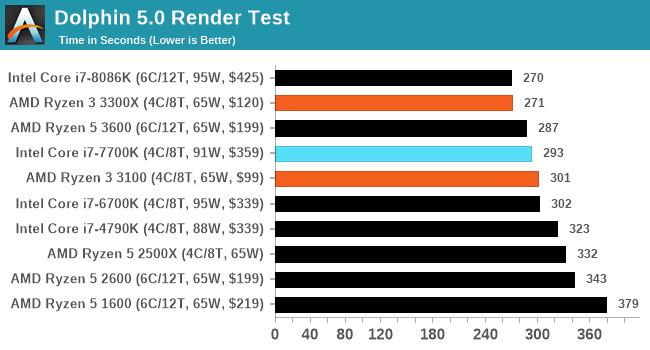
DigiCortex 1.20: Sea Slug Brain Simulation
This benchmark was originally designed for simulation and visualization of neuron and synapse activity, as is commonly found in the brain. The software comes with a variety of benchmark modes, and we take the small benchmark which runs a 32k neuron / 1.8B synapse simulation, equivalent to a Sea Slug.
Example of a 2.1B neuron simulation
We report the results as the ability to simulate the data as a fraction of real-time, so anything above a ‘one’ is suitable for real-time work. Out of the two modes, a ‘non-firing’ mode which is DRAM heavy and a ‘firing’ mode which has CPU work, we choose the latter. Despite this, the benchmark is still affected by DRAM speed a fair amount.
DigiCortex can be downloaded from http://www.digicortex.net/
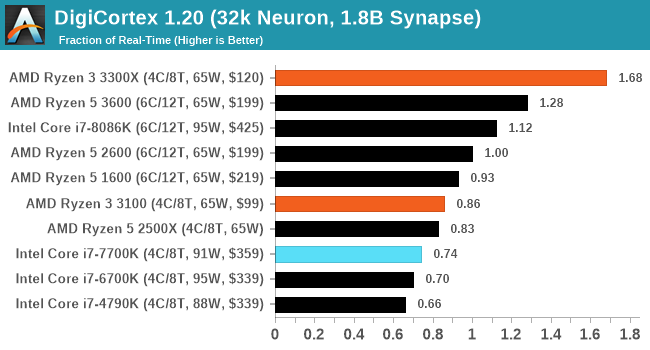
y-Cruncher v0.7.6: Microarchitecture Optimized Compute
I’ve known about y-Cruncher for a while, as a tool to help compute various mathematical constants, but it wasn’t until I began talking with its developer, Alex Yee, a researcher from NWU and now software optimization developer, that I realized that he has optimized the software like crazy to get the best performance. Naturally, any simulation that can take 20+ days can benefit from a 1% performance increase! Alex started y-cruncher as a high-school project, but it is now at a state where Alex is keeping it up to date to take advantage of the latest instruction sets before they are even made available in hardware.
For our test we run y-cruncher v0.7.6 through all the different optimized variants of the binary, single threaded and multi-threaded, including the AVX-512 optimized binaries. The test is to calculate 250m digits of Pi, and we use the single threaded and multi-threaded versions of this test.
Users can download y-cruncher from Alex’s website: http://www.numberworld.org/y-cruncher/
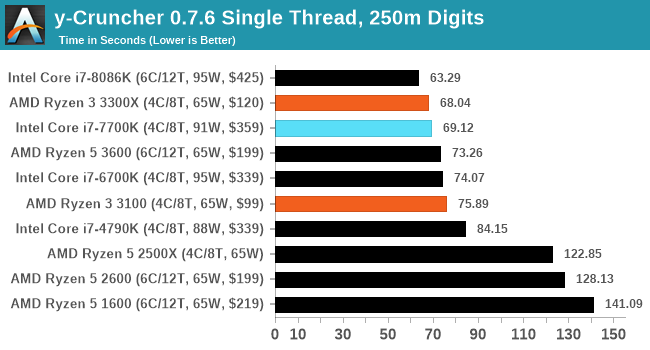
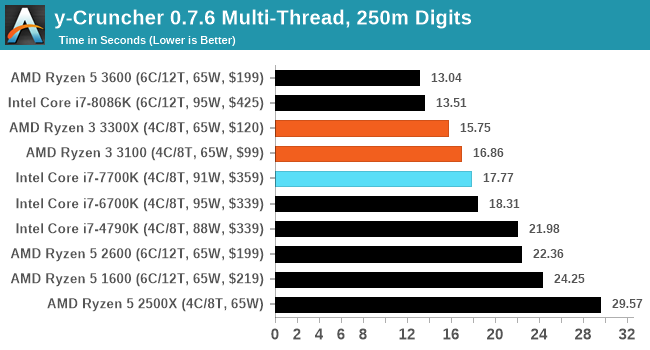
Agisoft Photoscan 1.3.3: 2D Image to 3D Model Conversion
One of the ISVs that we have worked with for a number of years is Agisoft, who develop software called PhotoScan that transforms a number of 2D images into a 3D model. This is an important tool in model development and archiving, and relies on a number of single threaded and multi-threaded algorithms to go from one side of the computation to the other.
In our test, we take v1.3.3 of the software with a good sized data set of 84 x 18 megapixel photos and push it through a reasonably fast variant of the algorithms, but is still more stringent than our 2017 test. We report the total time to complete the process.
Agisoft’s Photoscan website can be found here: http://www.agisoft.com/













249 Comments
View All Comments
alufan - Friday, May 8, 2020 - link
just curious if I follow the "bench" link it shows Intel at the top of the stack in the opening page, yet when I choose to look at the actual results with the drop down then the results change, yet the opening page is from a benchmark in which the Thread ripper has not even been tested on, the whole industry recognises that its probably the single fastest chip out there for the HEDT platform yet your opening page shows Intel at the top and no 2020 results, once again this looks like careful manipulation of the results and the casual viewer dropping on the page just sees the top 4 out of 6 positions taken by Intel with TR2 mixed in and no mention of TR3 not a very fair page and it gives a poor impression and a possibly misleading impression to folks who know no better and instantly get the impression Intel sells the highest performing CPUs which we know is not the case anymoreqwertymac93 - Friday, May 8, 2020 - link
There are two versions of "bench" for CPUs. "CPU" & "CPU 2019". You need the 2019 one to see the more recent results.alufan - Saturday, May 9, 2020 - link
and thats what I did clicked the link in the article and ended up with a page showing intel as having all the top spots which we all know is no longer the case...that was my point the opening summary page should reflect the results not the results of 2 years ago, and its now month5 of 2020 not 2019 "latest" results should be 2020zodiacfml - Friday, May 8, 2020 - link
This 3300x is something beats the six core 2600. In some reviews, it is equal to 3600 in games while a slightly behind in rendering tasks. I have already decided that a six-core is minimum for me since the 1600 but this...andrewaggb - Friday, May 8, 2020 - link
It's pretty good for what it is but for a cheap PC, intel has graphics. For a cheap gaming PC it's a bargain now but probably won't age well with 8 core consoles coming out this year. If you can afford the 3700x (or better), that should last 8+ years for gaming.Tchamber - Friday, May 8, 2020 - link
The Ryzen 3 3200G had preside graphics, too.ahenriquedsj - Saturday, May 9, 2020 - link
Good job.Mugur - Saturday, May 9, 2020 - link
Ian, sorry to say this, but you must find another organisation for you. Anandtech is just the ghost of what it was. You need at least what every youtuber has to conduct a decent set of benchmarks. You need to buy cpus, videocards, etc. for decent testbeds when they not sampled to you. I'm sick of seeing obscure outfits with every cpu and gpu possible, while a real expert is using a 1080 etc.Rudde - Saturday, May 9, 2020 - link
Will you update the conclusion to include 3100?lmcd - Saturday, May 9, 2020 - link
That board compatibility diagram must be flawed because my B350 board from ASRock has validated support for everything in the 3XXX series.